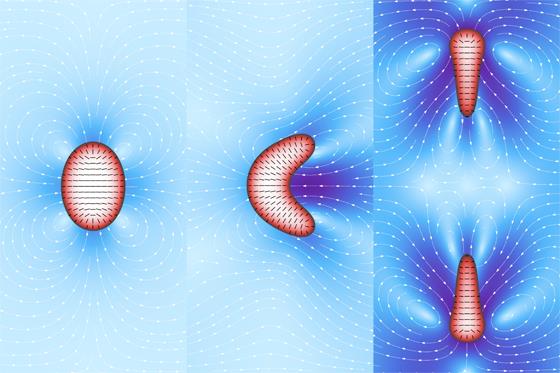Simulation Gives Clues About Forces Underlying Fundamental Cellular Processes
By LabMedica International staff writers
Posted on 28 Apr 2014
Researchers have developed a simulation model resulting in clues to physical conditions that help drive cell division and motility. The results may also hint at conditions that helped facilitate the original transition from inanimate to living matter.Posted on 28 Apr 2014
Active droplets of filamentous material enclosed in a lipid membrane are the main cell-like characteristics modeled in a program, developed by physicists Luca Giomi and Antonio DeSimone of the International School for Advanced Studies (SISSA; Scuola Internazionale Superiore di Studi Avanzati; Trieste, Italy), for numerical simulations to investigate the mechanics of “simplified” pre-cell structures. The simulations indicated a spontaneous emergence of features reminiscent of living material—of cell-like motility and division.

Image: Cell-like features in computer simulated active droplets: Left – static distortion; Middle – motility; Right: division (Photo courtesy of Dr. Luca Giomi and Dr. Antonio DeSimone, SISSA).
The model mimics some of the physical properties of cells: “Our ‘cells’ are a bare bones representation of a biological cell, which normally contains microtubules, elongated proteins, enclosed in an essentially lipid cell membrane," said Dr. Giomi; "The filaments contained in the ‘cytoplasm’ of our cells slide over one another exerting a force that we can control." The force exerted by the filaments is the variable that competes with another force, the surface tension that prevents the membrane surrounding the droplet from collapsing. This "competition" generates a flow in the fluid surrounding the droplet, and the droplet is in turn propelled by this self-generated hydrodynamic flow. When the flow becomes very strong, the droplet deforms to the point of dividing: "When the force of the flow prevails over the force that keeps the membrane together we have ‘cellular’ division," said Dr. DeSimone, director of the SISSA mathLab, SISSA's mathematical modeling and scientific computing laboratory.
"We showed that by acting on a single physical parameter in a very simple model we can reproduce similar effects to those obtained with experimental observations," continued Dr. DeSimone. Empirical observations on microtubule specimens have shown that these also move outside the cell environment, in a manner proportional to the energy they have (derived from ATP). "Similarly, our droplets, fuelled by their ‘inner’ energy alone—without forces acting from the outside—are able to move and even divide," he said.
The study, described in the April 10, 2014, online issue of the journal Physical Review Letters, is a step forward toward creating functional artificial cells and toward a better understanding of the first passages from which life has developed: "Acquiring motility and the ability to divide is a fundamental step for life and, according to our simulations, the laws governing these phenomena could be very simple. Observations like ours can prepare the way for the creation of functioning artificial cells, and not only," said Dr. Giomi. "Our work is also useful for understanding the transition from non-living to living matter on our planet." Chemists and biologists who study the origin of life lack access to cells that are sufficiently simple. "Even the simplest organism existing today has undergone billions of years of evolution, and will always contain fairly complex structures," noted Dr. Giomi.
Related Links:
SISSA, International School for Advanced Studies













